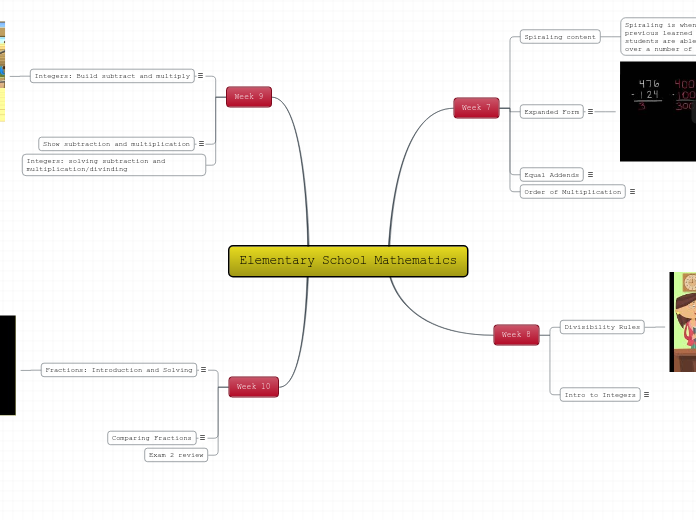realizată de Gemma Roman 4 ani în urmă
221
Elementary School Mathematics

realizată de Gemma Roman 4 ani în urmă
221

Mai multe ca acesta
Comparing Fraction:
For this, we will be using signs that are less than, greater than, and equal too signs, < = >.
If a fraction has a whole number in front of it, depending on the whole number is where the less than greater than sign will be facing.
Anchor Fractions, are fractions that we know then off the bat, 1/2
Doubling the top number, if its bigger than the denominator means its over 1/2, if its less then its less than 1/2.
Ex:
7/13 11/23
doubled
14/13 22/46
so, we know that 14/13 is the greater.
7/13 > 22/46
Next:
2/9 2/7
For this 2/7 is greater because of the number of pieces.
2/9 < 2/7
Then:
If we were to draw out the fractions, it will help us understand the sizing. When we see fractions that are almost whole numbers.
Intro to fractions:
4 ->The number of things we have
6 ->Size of pieces
Solving:
When solving fractions the thing to notice to do the easy problems first.
Ex: 14 + 5 1/3
=19 1/3
Since there wasn't a fraction attached to the first number you can just add across.
When given this problem 2/9 + 3/9, this means we have the same size pieces, so we add across or subtract, but keep the bottom number the same. 5/9
Showing Subtraction and Multiplication:
When showing subtraction using the actual symbols for negative and positive and using their colors, blue for positive and red for negative.
This is the same as building out the problems, the only different is using the actual signs for negative and positive.
Building Subtraction and Multiplication :
The best way to start with subtraction is to figure out what the best way to say the problem out.
-4-(-3)
This is 4 negatives take away 3 negatives.
Using the colors red and yellow for the negative and positives will help when building these problems out.
Zero Banks:
These are as big as we need them to be, or big enough. We use them to help us see the numbers we need to take away.
When given a problem, use the counters. If given -3 use three red counters, so it shows its a negative number. Given 5, use 5 yellows.
Integers:
Any numbers that have positive or negative value.
Having two colored counters will be able to help show what you are building. Preferably red and yellow counters, or two different counters.
When going to add integers make sure the right color of your counter is showing. Plus keep in mind zero pairs. A zero pair is when you add integers together that cancel each other out.
Positives belong on top of negatives.
Red=Negative, Yellow= Positive
EX:
000 Here we have the number 1
00
For this chapter we learned about Times Tests. We learned that they aren't efficient for helping students learn how to multiply. Instead, they show that students dont learn their times table and will eventually forget it. Research show's that these are not the best ways to show children their times table.
Multiplication:
The best way to learn multiplication facts are by starting with
1s, 2s, 10s, and 5s.
Next is 3s, 9s, and the doubles.
Lastly they need to learn 4s, 6s, 7s, and 8s
Left to Right:
Rewriting the problem from left to right. Then multipleyou s the numbers on the bottom left first. The work your way to the right.
4 2
|/ \|
1 3
400
20
6
120
546
Lattice:
This is where you set up the lattice. We create a box. You have to make sure one number is on the top, and the other on the right hand side.
2 0
| / 8 | / 0 |4
| / 4| / 0 |2
8 / 4 / 0 = 840
Equal Addends, this is where the idea is used in subtraction. The problem is rewritten, and turn one of the numbers so that its easier to subtract. As long as you add the equal amount to both numbers, you can add whatever you want. You have to do the same number to both of the numbers you are subtracting.
Ex: 43-17
43+3 = 46
-17+3 = 20
26
Expanded form is when you expand the numbers to their whole number to make subtracting easier.
Ex: 459-324
400+50+9
-300+20+4
100+30+5 =135